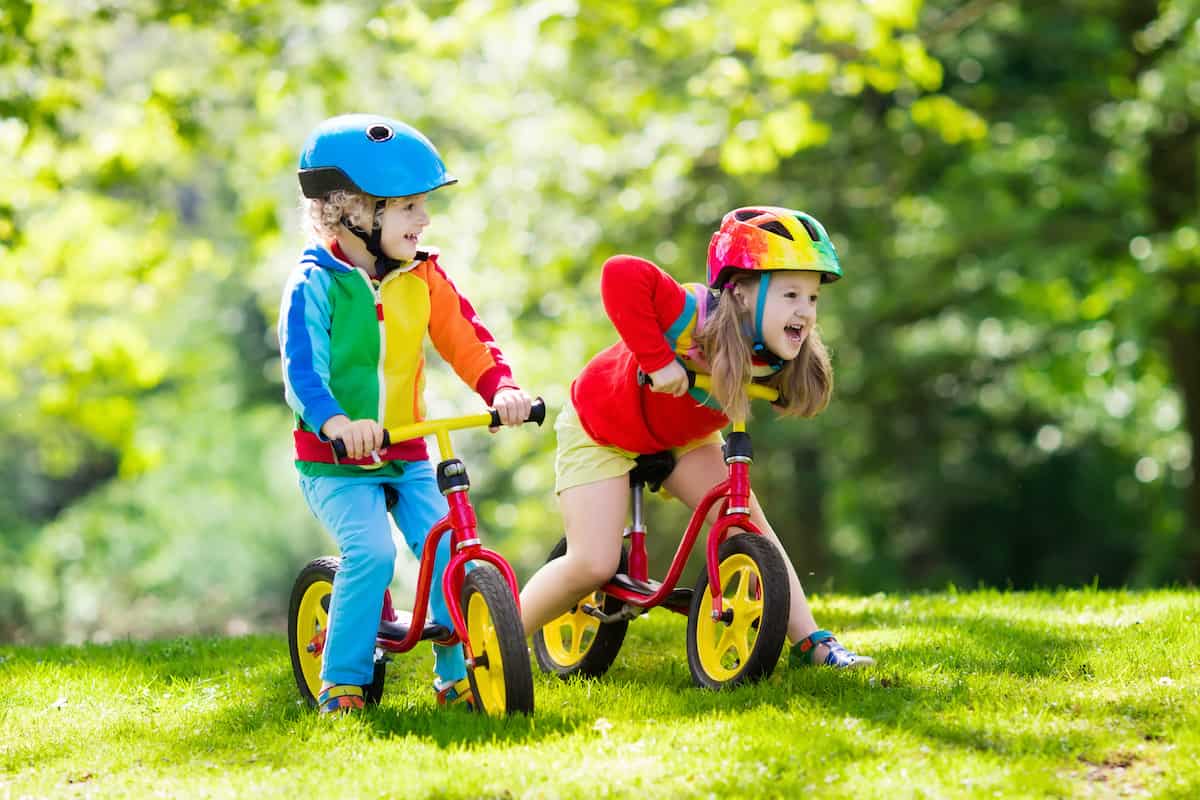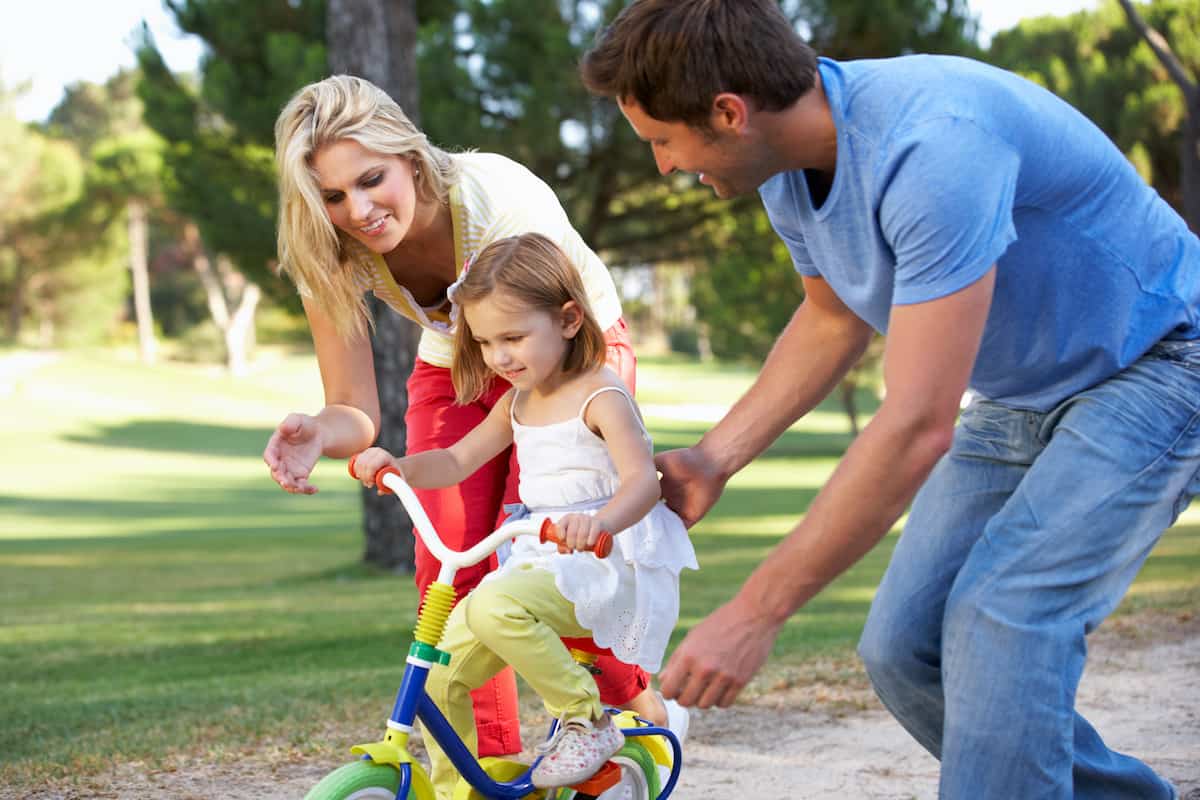How To Quickly Teach a Kid to Ride a Bike

My youngest child just started to ride a two-wheeled bike. And I can’t get her to stop. She began practicing on Thursday and by Sunday was able to ride with us on a mile-long evening family bike ride. Second to learning to swim, this is the proudest and most confident I’ve seen her, and the best she’s slept at night.
How to Quickly Teach a Kid to Ride a Bike
Riding a bike is a life skill. Many of us take for granted the ability to jump on a bicycle and ride for fun, for exercise, and for transport. We forget that there was a time when we didn’t know how to do it. We forget that someone had to teach us.
Give your kids the gift of riding a bike. The younger they learn the better. The longer you wait, issues such as embarrassment take over, making learning even harder.
Quickly Teach a Kid to Ride a Bike with Motivation
Your child must be motivated to learn to ride a bicycle. For some kids, this is as easy as the adult saying “Let’s learn to ride a two-wheeled bike!” For other kids, outside motivation is necessary and peer motivation is the best.
Older siblings are excellent motivators (and teachers) of bike riding. Often younger siblings do not like being slower (and louder!) on bikes with training wheels. They want to keep up and will pick up the new skill in order to not be left behind.
If siblings aren’t present to motivate, have your child watch their friends on a bike ride. My child is always motivated by seeing children younger than her demonstrate a skill.
During COVID-19 quarantine, our neighborhood has seen the comeback of the bicycle. One kid sees another learn and then wants to try it. They cheer for each other and offer tips to the new rider.

Quickly Teach a Kid to Ride a Bike by Teaching Balance
Training wheels are misnamed. A bike with training wheels only introduces a kid to the size of a two-wheeled bike, not the balance. To quickly teach a kid to ride a bike you must focus on balance.
Consider removing one training wheel to teach balance. My oldest daughter quickly learned to ride a bike because the training wheels on her bike were so lopsided she had to learn to balance.
The Glide Method Helps to Teach Balance
Seen a four-year-old around “biking” with no pedals? Balance bikes teach the skills needed to ride a two-wheeled bike. Balance bikes do not have a pedal on either side. Young riders scoot along on their feet and when their feet get tired, they have to balance. Since they have mastered balance, they often move smoothly into using a pedal bike.
The Glide Method applies the balance bike concept to any age or size rider with their own bike. Remove each pedal from any bike and lower the seat height so the rider’s feet can touch the ground. The adult or kid rider then sits back on the bike saddle, pushes off with one foot, then the other foot, and then glides.
After a few times, when the beginning cyclist can balance for a few seconds, add each pedal back on and continue practicing.

Avoid Running Alongside or Holding on to the Bike
Every parent wants to run right next to the learning biker and hold the seat or handlebars until just the moment when the child ready. Except this is nerve-racking for kids and physically awkward for both involved.
Even if it is the first lesson, running next to a bike and/or holding onto the seat will create more wobbling when the child learning to balance. Doing this will slow your progress in the two-wheeled world. It may not help the parent/child relationship much either.
Teaching Steering to Quickly Teach a Kid to Ride a Bike
When a child is comfortable and confident with balance they can learn to turn and steer the bicycle. An open parking lot, grassy field are great places for teaching. Remember, coronavirus social distancing guidelines do not prevent bicyclists from practicing skills, even if they are brand new.
Teach steering by having the cyclist practice large, wide circles and figure 8’s. It’s important to be practicing in an empty open space so the learner can concentrate on turning and steering without distractions or needing to know the Rules of the Road.
You can also set up cones and make obstacle courses. Make it fun in order to keep their interest and downplay discouraging moments.
Teaching Slowing and Stopping
If the child has hand brakes, have them walk next to the bike and practice slowing and stopping using the brakes.
If the child has coaster brakes, this is the chance for the parent to hold onto the bike! Hold the bike while they practice pushing down on the brake with their foot until they can do it and remain balanced.

To Quickly Teach a Child to Ride a Bike, Have all the Gear
To quickly teach a child how to ride a bike be sure to have the right protective gear before you start. You do not want to risk an injury that would certainly discourage learning or worse. At the same time, you also want to establish proper bicycle safety from the very beginning.
A helmet that fits properly is crucial. Beyond the helmet, you may want to use elbow pads. Make sure the child has secure footwear and is not wearing long, billowy clothing that could get caught in the wheels. (Leave the superman cape off -for now.)
And Have all the Fun
Be sure to be encouraging and have fun! If you feel things getting stressful (with either of you) take a break and get back at it later. Cycling is an independent skill that will last a lifetime. Biking together provides great shared experiences for families. Give the gift to your child with joy…and don’t hold onto the seat!





